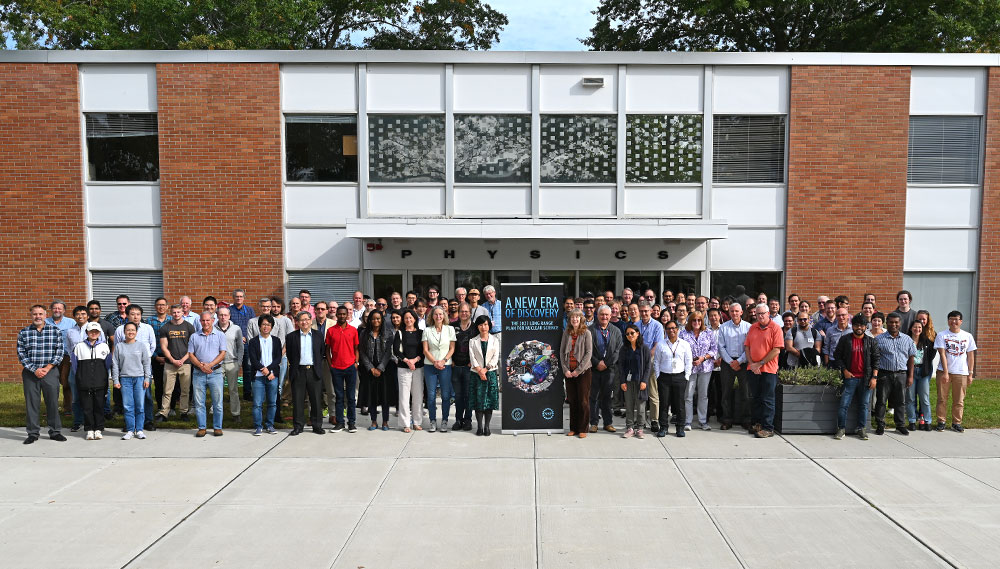Packed Crowd Attends Brookhaven Lab's Nuclear Physics Long Range Plan Roll-Out Event
Brookhaven staff play key roles in many of the Plan's main recommendations, including research at the Relativistic Heavy Ion Collider, building the future Electron-Ion Collider, and training America's nuclear science workforce
October 23, 2023
 enlarge
enlarge
Attendees gathered for a group photo outside the Brookhaven Lab physics building after the nuclear science Long Range Plan roll-out event on Oct. 6, 2023.
On Friday, Oct. 6, 2023, a crowd packed into the Large Seminar Room in the Physics Department at the U.S. Department of Energy’s (DOE) Brookhaven National Laboratory to hear from Lab management and members of the Nuclear Science Advisory Committee (NSAC) about the field’s vision for the future. The event was one of 20 taking place simultaneously at nuclear physics research institutions across the country to roll out the 2023 NSAC Long Range Plan, A New Era of Discovery.
After a welcome from Brookhaven Lab Director JoAnne Hewett and opening remarks from Associate Laboratory Director for Nuclear and Particle Physics Haiyan Gao, the audience tuned into a live Zoom presentation from NSAC Chair Gail Dodge of Old Dominion University. Dodge described the community-wide process for gathering input before arriving at recommendations to ensure that federal investments in nuclear physics reflect the national interest and maintain U.S. leadership.
Dodge then laid out the Plan’s four major recommendations:
- Capitalizing on the extraordinary opportunities for scientific discovery made possible by the substantial and sustained investments of the United States in nuclear physics by increasing the research budget; efficiently operating the major DOE Office of Science user facilities and completing the science program at the Relativistic Heavy Ion Collider (RHIC) at Brookhaven Lab; raising the compensation rate for graduate researchers to lower barriers and expand opportunities in STEM and boost national competitiveness; and expanding policy and resources to ensure a safe and respectful environment for everyone.
- A campaign of ton-scale neutrinoless double beta decay experiments using different isotopes and complementary techniques—the highest priority for new experiment construction.
- The expeditious completion of the Electron-Ion Collider (EIC)—the highest priority for facility construction.
- Capitalizing on the unique ways in which nuclear physics can advance discovery science and applications for society by investing in additional projects such as upgrades to existing facilities; detector and accelerator research and development; investments in quantum-based computing and sensing; and advances in nuclear data essential to medicine, energy, national security, nonproliferation, and space exploration.
Hover over image to reveal slideshow controls.
Dodge described how discoveries in nuclear science advance our understanding of nature and enable new technological breakthroughs and innovations, leading to applications with broad societal benefits in the fields of medicine, energy, data science, national security, and more. She noted that the Plan contains detailed strategies for attracting and retaining the technically skilled workforce needed to address both the science and these societal needs.
Gao then returned to the stage to give an overview of the local impacts for Brookhaven. She noted how Brookhaven scientists play key roles in all of the Plan’s major recommendations, by carrying out the research program at RHIC; contributing to heavy-ion research at Europe’s Large Hadron Collider; constructing the EIC; having active engagement in nEXO—one of the international collaborations planning a neutrinoless double beta decay experiment; and leading in the fields of nuclear data, computing, quantum information science, and artificial intelligence/machine learning. She also described the Lab’s contributions to multidisciplinary and topical collaborations, nuclear theory, and applications of nuclear physics—such as the production of medical isotopes and research into the effects of space radiation—as well as Brookhaven’s highly visible efforts in nuclear science workforce development.
Brookhaven Lab physicist Lijuan Ruan, a co-spokesperson for RHIC’s STAR experiment and member of the NSAC Long Range Plan writing committee, then gave more details on the research planned for the future at RHIC and the EIC. She was followed by Brookhaven Lab nuclear theorist Bjoern Schenke, also on the writing committee, who described how the Plan emphasizes the essential interplay of theory, computation, and experimental work throughout its descriptions of the compelling science put forth in the recommendations.
“We are excited to see that completing the science program at RHIC and completion of the EIC are included in the Plan’s major recommendations, along with supporting the nuclear science workforce essential to the research at nuclear science facilities and universities across the U.S.,” said Brookhaven Lab Director JoAnne Hewett, who endorsed the plan in its entirety. “Together, these recommendations will make the field stronger and build on a decades-long track record of reliable stewardship of public funds and demonstrated success in achieving its long-term goals,” she said. “We look forward to working with the Department of Energy, the National Science Foundation, and the nuclear physics community to implement its comprehensive recommendations.”
Watch the full event recording.
Brookhaven National Laboratory is supported by the Office of Science of the U.S. Department of Energy. The Office of Science is the single largest supporter of basic research in the physical sciences in the United States and is working to address some of the most pressing challenges of our time. For more information, visit science.energy.gov.
Follow @BrookhavenLab on social media. Find us on Instagram, LinkedIn, Twitter, and Facebook.
2023-21515 | INT/EXT | Newsroom










